You are using an out of date browser. It may not display this or other websites correctly.
You should upgrade or use an alternative browser.
You should upgrade or use an alternative browser.
pls give thoughts on this natural round cut Diamond d class Diamond. TIA
- Thread starter tmoon19
- Start date
- Status
- Not open for further replies. Please create a new topic or request for this thread to be opened.
- Joined
- Apr 23, 2018
- Messages
- 5,870
Love the D color and size. Unfortunately it falls short on cut and not something I would purchase or recommend.
Is this a stone you are considering or that you own? Perhaps we can help find you a nicer stone.
Love the D color and size. Unfortunately it falls short on cut and not something I would purchase or recommend.
Is this a stone you are considering or that you own? Perhaps we can help find you a nicer stone.
Thank you for your input. It is a stone I was considering bc we tried it on at the store. Can you please elaborate on why the cut falls short!
headlight
Ideal_Rock
- Joined
- Nov 2, 2003
- Messages
- 3,355
- Joined
- Apr 23, 2018
- Messages
- 5,870
In short, a well cut diamond will allow light to enter, then bounce around and return through the top which produces that magical rainbow light we call “fire”. Below is a graphical illustration that shows what I mean.
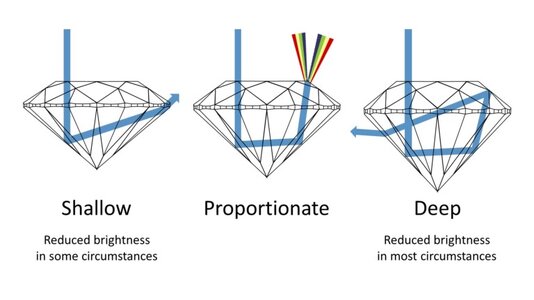
Notice how the shallow and deep stones have different light paths and light doesn’t return to the top? This does two things — produces less fire and also less brightness. Fire is very obvious but edge to edge brightness becomes important when you are in low light conditions. A poorly cut stone can magically “shrink” in certain conditions. We often recommend to look at a stone outside of jewelers lighting because they typically use high powered lights to flood the stone with excess light and show the very best case scenario. Looking at the stone under office lighting, near a window, etc can often reveal different results.
Below is an example of two stones in different lighting conditions. Notice how stone A is better cut and performs better in both conditions.
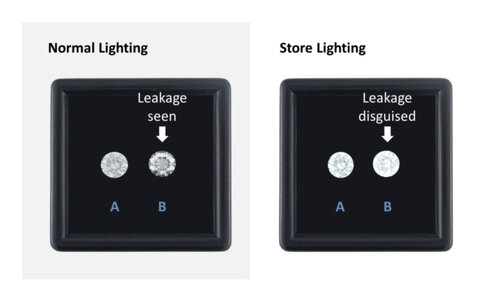
As you are probably gathering, the angle at which light enters the stone and bounces around is very important to finding a well cut stone. All those angles and percentages you posted off the stone gives us an idea how light will behave and are collectively called “proportions”. When evaluating the proportions of the stone it’s important to understand they all work in harmony, or relation, to one another.
In your case, @headlight has pointed out the table is very large at 62. For ideal cut stones, we normally want to see 54-57. The overall depth of 60.8 is within the typical preferred range; however, as pointed out the table is larger than the depth which doesn’t yield optimal results.
The crown angle of 34.5 is good but the pavilion angle of 41 is risky. It really depends how tightly cut the stone is and we can’t determine that with proportions only. When looking at values on the lab report it’s important to understand there are 8 actual crown and 8 actual pavilion angles. GIA averages the crowns and rounds them to the nearest 0.5 degree. And they average the pavilions and round to the nearest 0.2 degrees. So there is some variance, we just don’t know how much. If some of those pavilions are closer to 40.8 they would play better with the 34.5 crowns. Just as 34 crowns would play a little nicer with 41 pavilions. Additionally I have concern about going > 41.2 on the actual pavilion angles.
However, with the table and other proportions being out of harmony it’s really not a worthwhile pursuit to examine further. Simply stated, there are other stones with better proportions that will give a higher probability of better cut and more fire.
And while not related to cut, the cavity inclusion is something that I also dislike. Admittedly it’s a VS2 and least/4th critical of the inclusions. However, unless the stone is super rare then it’s simply easier to walk away from a cavity. There are plenty of stones without them. Now if you found a polka dotted zebra, it may be worth considering but that isn’t the case here.

Notice how the shallow and deep stones have different light paths and light doesn’t return to the top? This does two things — produces less fire and also less brightness. Fire is very obvious but edge to edge brightness becomes important when you are in low light conditions. A poorly cut stone can magically “shrink” in certain conditions. We often recommend to look at a stone outside of jewelers lighting because they typically use high powered lights to flood the stone with excess light and show the very best case scenario. Looking at the stone under office lighting, near a window, etc can often reveal different results.
Below is an example of two stones in different lighting conditions. Notice how stone A is better cut and performs better in both conditions.

As you are probably gathering, the angle at which light enters the stone and bounces around is very important to finding a well cut stone. All those angles and percentages you posted off the stone gives us an idea how light will behave and are collectively called “proportions”. When evaluating the proportions of the stone it’s important to understand they all work in harmony, or relation, to one another.
In your case, @headlight has pointed out the table is very large at 62. For ideal cut stones, we normally want to see 54-57. The overall depth of 60.8 is within the typical preferred range; however, as pointed out the table is larger than the depth which doesn’t yield optimal results.
The crown angle of 34.5 is good but the pavilion angle of 41 is risky. It really depends how tightly cut the stone is and we can’t determine that with proportions only. When looking at values on the lab report it’s important to understand there are 8 actual crown and 8 actual pavilion angles. GIA averages the crowns and rounds them to the nearest 0.5 degree. And they average the pavilions and round to the nearest 0.2 degrees. So there is some variance, we just don’t know how much. If some of those pavilions are closer to 40.8 they would play better with the 34.5 crowns. Just as 34 crowns would play a little nicer with 41 pavilions. Additionally I have concern about going > 41.2 on the actual pavilion angles.
However, with the table and other proportions being out of harmony it’s really not a worthwhile pursuit to examine further. Simply stated, there are other stones with better proportions that will give a higher probability of better cut and more fire.
And while not related to cut, the cavity inclusion is something that I also dislike. Admittedly it’s a VS2 and least/4th critical of the inclusions. However, unless the stone is super rare then it’s simply easier to walk away from a cavity. There are plenty of stones without them. Now if you found a polka dotted zebra, it may be worth considering but that isn’t the case here.
NY_Resonant
Shiny_Rock
- Joined
- Jan 23, 2023
- Messages
- 450
Thank you for your input. It is a stone I was considering bc we tried it on at the store. Can you please elaborate on why the cut falls short!
62 table stones are tricky. The “ideal proportions” to optimize cut become a much smaller range and in fact the needed crown/pavilion angle becomes much different than for the usual 54-58 table stone discussed on this board.
As you can see on the cut estimator website, this stone barely falls in GIA 3X and is not near the AGS Ideal needed proportions. Now you tack on GIA rounding of the numbers into it and this could easily fall outside of the GIA 3X category with many pavilion Angie’s at 40.9, etc.
Cut Estimator – Diamond Screener
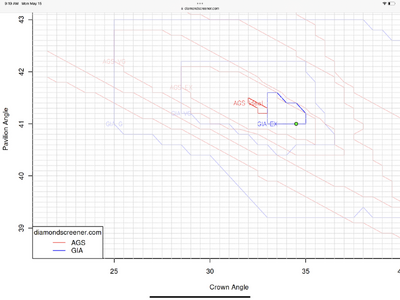
I love brilliant stones produced by the 60/60 ratio type diamonds, even if they lose a bit on the fire side. Personally I have nothing against the 62 table itself, I know for a fact they can produce brilliant gorgeous diamonds... but a 62 table introduces a lot of RISK and you need to be very comfortable with loving it with your own eyes in person.
Make sure you compare it with ideal cut stones in person in various lighting before deciding (Not just store lighting!).
62 table stones are tricky. The “ideal proportions” to optimize cut become a much smaller range and in fact the needed crown/pavilion angle becomes much different than for the usual 54-58 table stone discussed on this board.
As you can see on the cut estimator website, this stone barely falls in GIA 3X and is not near the AGS Ideal needed proportions. Now you tack on GIA rounding of the numbers into it and this could easily fall outside of the GIA 3X category with many pavilion Angie’s at 40.9, etc.
Cut Estimator – Diamond Screener
www.diamondscreener.com
I love brilliant stones produced by the 60/60 ratio type diamonds, even if they lose a bit on the fire side. Personally I have nothing against the 62 table itself, I know for a fact they can produce brilliant gorgeous diamonds... but a 62 table introduces a lot of RISK and you need to be very comfortable with loving it with your own eyes in person.
Make sure you compare it with ideal cut stones in person in various lighting before deciding (Not just store lighting!).
Thanks for the input. What do you think about this one ?

In short, a well cut diamond will allow light to enter, then bounce around and return through the top which produces that magical rainbow light we call “fire”. Below is a graphical illustration that shows what I mean.
Notice how the shallow and deep stones have different light paths and light doesn’t return to the top? This does two things — produces less fire and also less brightness. Fire is very obvious but edge to edge brightness becomes important when you are in low light conditions. A poorly cut stone can magically “shrink” in certain conditions. We often recommend to look at a stone outside of jewelers lighting because they typically use high powered lights to flood the stone with excess light and show the very best case scenario. Looking at the stone under office lighting, near a window, etc can often reveal different results.
Below is an example of two stones in different lighting conditions. Notice how stone A is better cut and performs better in both conditions.
As you are probably gathering, the angle at which light enters the stone and bounces around is very important to finding a well cut stone. All those angles and percentages you posted off the stone gives us an idea how light will behave and are collectively called “proportions”. When evaluating the proportions of the stone it’s important to understand they all work in harmony, or relation, to one another.
In your case, @headlight has pointed out the table is very large at 62. For ideal cut stones, we normally want to see 54-57. The overall depth of 60.8 is within the typical preferred range; however, as pointed out the table is larger than the depth which doesn’t yield optimal results.
The crown angle of 34.5 is good but the pavilion angle of 41 is risky. It really depends how tightly cut the stone is and we can’t determine that with proportions only. When looking at values on the lab report it’s important to understand there are 8 actual crown and 8 actual pavilion angles. GIA averages the crowns and rounds them to the nearest 0.5 degree. And they average the pavilions and round to the nearest 0.2 degrees. So there is some variance, we just don’t know how much. If some of those pavilions are closer to 40.8 they would play better with the 34.5 crowns. Just as 34 crowns would play a little nicer with 41 pavilions. Additionally I have concern about going > 41.2 on the actual pavilion angles.
However, with the table and other proportions being out of harmony it’s really not a worthwhile pursuit to examine further. Simply stated, there are other stones with better proportions that will give a higher probability of better cut and more fire.
And while not related to cut, the cavity inclusion is something that I also dislike. Admittedly it’s a VS2 and least/4th critical of the inclusions. However, unless the stone is super rare then it’s simply easier to walk away from a cavity. There are plenty of stones without them. Now if you found a polka dotted zebra, it may be worth considering but that isn’t the case here.
thank you for your response! I learned a lot. Do you think these proportions may be better ?
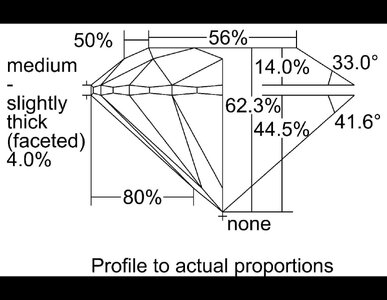
NY_Resonant
Shiny_Rock
- Joined
- Jan 23, 2023
- Messages
- 450
Read this link: https://www.pricescope.com/education/diamond-cut/diamond-proportions
Focus on the bright balanced, fiery balanced and all around proportions. Most people on this forum will recommend sticking only to the all-around proportions since with GIA rounding, when you go to the bright balanced or fiery balanced proportions you introduce a bit more complexity In needing to pair specific crown angles with specific pavilion angles.
That diamond you shows with a 56 table and a 41.6 pavilion is a no-go.
- Joined
- Jul 31, 2014
- Messages
- 20,147
Read this link: https://www.pricescope.com/education/diamond-cut/diamond-proportions
Focus on the bright balanced, fiery balanced and all around proportions. Most people on this forum will recommend sticking only to the all-around proportions since with GIA rounding, when you go to the bright balanced or fiery balanced proportions you introduce a bit more complexity In needing to pair specific crown angles with specific pavilion angles.
That diamond you shows with a 56 table and a 41.6 pavilion is a no-go.
This
- Joined
- Apr 23, 2018
- Messages
- 5,870
While the table on this one is better, the depth has increased to 62.3 which is on the fringe. Normally you want to stay 62 or less.
Crown is too shallow at 33 and pavilion too deep at 41.6. On pavilion you really want to stay at 41 and lower. Weird stuff happens at 41.2. And because of averaging and rounding 41 is somewhat on the fringe but can work if tightly cut.
Again, as we change a single proportion the light path changes direction. Here we have changed several of the proportions in an attempt but it hasn’t gotten us to that ideal sweet spot yet.
Using this criteria is strict but will yield results that will show more potential to be a winner. And keep in mind, proportions alone don’t make it a great stone. Yes, it needs proper angles to have a shot but also symmetry and cut nuances can still come into play.
54-57 table
60-62 depth
34-35 crown
40.6-41 pavilion
75-80 LGF’s
In regards to the crown/pavilion, ideally it will have an inverse relationship meaning steep crown/shallow pavilion (35/40.6) or maybe a shallow crown/steep pavilion (34/41). Another popular combo is a 34.5/40.8.
You want to avoid things like steep crown/steep pavilion (35/41) as it will almost certainly have some leakage.
What is your budget, and your other constraints regarding color, clarity and size? We could toss a few options your way for consideration.
If you want to simplify the process, ensure you get an ideal cut stone and have all the assurance with advanced images, etc you may want to consider a super ideal stone such as an ACA from WhiteFlash (WF). It’s literally like hitting an easy button to get an amazing performer. Also, they have one of the best trade/upgrade programs around — you get 100% of your original purchase towards a new stone of equal or greater value, no other strings.
Crown is too shallow at 33 and pavilion too deep at 41.6. On pavilion you really want to stay at 41 and lower. Weird stuff happens at 41.2. And because of averaging and rounding 41 is somewhat on the fringe but can work if tightly cut.
Again, as we change a single proportion the light path changes direction. Here we have changed several of the proportions in an attempt but it hasn’t gotten us to that ideal sweet spot yet.
Using this criteria is strict but will yield results that will show more potential to be a winner. And keep in mind, proportions alone don’t make it a great stone. Yes, it needs proper angles to have a shot but also symmetry and cut nuances can still come into play.
54-57 table
60-62 depth
34-35 crown
40.6-41 pavilion
75-80 LGF’s
In regards to the crown/pavilion, ideally it will have an inverse relationship meaning steep crown/shallow pavilion (35/40.6) or maybe a shallow crown/steep pavilion (34/41). Another popular combo is a 34.5/40.8.
You want to avoid things like steep crown/steep pavilion (35/41) as it will almost certainly have some leakage.
What is your budget, and your other constraints regarding color, clarity and size? We could toss a few options your way for consideration.
If you want to simplify the process, ensure you get an ideal cut stone and have all the assurance with advanced images, etc you may want to consider a super ideal stone such as an ACA from WhiteFlash (WF). It’s literally like hitting an easy button to get an amazing performer. Also, they have one of the best trade/upgrade programs around — you get 100% of your original purchase towards a new stone of equal or greater value, no other strings.
momofive
Brilliant_Rock
- Joined
- Mar 13, 2011
- Messages
- 1,056
I hope you take advantage of the pros on here. They eat, drink and sleep diamonds and are unbiased. If you give your general requirements and budget, they will try to find you the best stone for your money. It can't hurt to try, you don't have to buy it.
Diamond buying is tricky business, made trickier by unscrupulous vendors. This is the best place I've found for advice. Take the time to do some research of the site and you will see what I mean. Eat, drink and sleep! LOL
Diamond buying is tricky business, made trickier by unscrupulous vendors. This is the best place I've found for advice. Take the time to do some research of the site and you will see what I mean. Eat, drink and sleep! LOL
DejaWiz
Ideal_Rock
- Joined
- Apr 23, 2021
- Messages
- 7,204
Yes: Please, let us help you find a perfectly cut and proportioned diamond with maximum optical performance. Just let us know the basics of what your diamond budget is and what color range, clarity, and min carat target you're wanting.
Thanks! Would like to stay in colorless range, clarity up to VS2, 2 carats! Budget is anywhere from 25-30
NY_Resonant
Shiny_Rock
- Joined
- Jan 23, 2023
- Messages
- 450
Thanks! Would like to stay in colorless range, clarity up to VS2, 2 carats! Budget is anywhere from 25-30
Hopefully others find more options within your parameters and budget. One that I found for your consideration is this at 26k: https://dreamstone.com/loose-diamon...tm_medium=referral&utm_campaign=stonealgo.com
Hopefully others find more options within your parameters and budget. One that I found for your consideration is this at 26k: https://dreamstone.com/loose-diamon...tm_medium=referral&utm_campaign=stonealgo.com
Thank you! I noticed there’s faint fluorescence. Would you guys recommend no fluorescence ?
momofive
Brilliant_Rock
- Joined
- Mar 13, 2011
- Messages
- 1,056
I’m not an expert, but I can tell you that fluorescence is subjective. Some people like it because they think it gives a white “feeling” to the diamond. Others avoid it completely. I don’t think faint fluorescence would bother me, but you’d have to see it in person to know for yourself. You can go to a store and ask to see a diamond with faint fluorescence.
I can’t tell about this diamond. I can see the arrows, but only some are dark and I don’t know if that would be a negative. I do see that the table is at 14.5% and I know the pros on here like 15% or better, but there are exceptions. Wait for them to chime in. They’ll be happy to help.
I can’t tell about this diamond. I can see the arrows, but only some are dark and I don’t know if that would be a negative. I do see that the table is at 14.5% and I know the pros on here like 15% or better, but there are exceptions. Wait for them to chime in. They’ll be happy to help.
- Joined
- Dec 17, 2008
- Messages
- 28,398
DejaWiz
Ideal_Rock
- Joined
- Apr 23, 2021
- Messages
- 7,204
See if they can get you Ideal-Scope or ASET scope images for this one:
 www.ritani.com
www.ritani.com
2.00 Carat Round Diamond GIA 2466160468 | Ritani
2 Carat Round Earth Diamond ID Cut D Color VS2 Clarity with diamond report number GIA #2466160468
- Joined
- Jul 31, 2014
- Messages
- 20,147
Thank you! I noticed there’s faint fluorescence. Would you guys recommend no fluorescence ?
Faint is not an issue at all
While the table on this one is better, the depth has increased to 62.3 which is on the fringe. Normally you want to stay 62 or less.
Crown is too shallow at 33 and pavilion too deep at 41.6. On pavilion you really want to stay at 41 and lower. Weird stuff happens at 41.2. And because of averaging and rounding 41 is somewhat on the fringe but can work if tightly cut.
Again, as we change a single proportion the light path changes direction. Here we have changed several of the proportions in an attempt but it hasn’t gotten us to that ideal sweet spot yet.
Using this criteria is strict but will yield results that will show more potential to be a winner. And keep in mind, proportions alone don’t make it a great stone. Yes, it needs proper angles to have a shot but also symmetry and cut nuances can still come into play.
54-57 table
60-62 depth
34-35 crown
40.6-41 pavilion
75-80 LGF’s
In regards to the crown/pavilion, ideally it will have an inverse relationship meaning steep crown/shallow pavilion (35/40.6) or maybe a shallow crown/steep pavilion (34/41). Another popular combo is a 34.5/40.8.
You want to avoid things like steep crown/steep pavilion (35/41) as it will almost certainly have some leakage.
What is your budget, and your other constraints regarding color, clarity and size? We could toss a few options your way for consideration.
If you want to simplify the process, ensure you get an ideal cut stone and have all the assurance with advanced images, etc you may want to consider a super ideal stone such as an ACA from WhiteFlash (WF). It’s literally like hitting an easy button to get an amazing performer. Also, they have one of the best trade/upgrade programs around — you get 100% of your original purchase towards a new stone of equal or greater value, no other strings.
hello, what are your thoughts on this one https://www.bluenile.com/diamond-de...=PriceScope&utm_campaign=Online+Tracking+Link
thank you!
Faint is not an issue at all
thoughts on this one? https://www.bluenile.com/diamond-de...=PriceScope&utm_campaign=Online+Tracking+Link
- Joined
- Jul 31, 2014
- Messages
- 20,147
I like it except it has a knot. Most people avoid stones w knots as the main inclusion
musicloveranthony
Brilliant_Rock
- Joined
- Feb 1, 2014
- Messages
- 1,692
musicloveranthony
Brilliant_Rock
- Joined
- Feb 1, 2014
- Messages
- 1,692
The knot
- Joined
- Dec 17, 2008
- Messages
- 28,398
musicloveranthony
Brilliant_Rock
- Joined
- Feb 1, 2014
- Messages
- 1,692
Looks like the crystal to me. The knot is more towards the outside of the table and the crystal is more towards the center.
Thing I'm seeing is more towards the center. Does it matter?
You're right! Good call
- Joined
- Jul 31, 2014
- Messages
- 20,147
- Status
- Not open for further replies. Please create a new topic or request for this thread to be opened.
Share:
How Are Diamonds Made? Natural vs Lab-Created Explained How Are Diamonds Made? Natural vs Lab-Created Explained - 08/05
How Are Diamonds Made? Natural vs Lab-Created Explained - 08/05

Top Wedding Ring Brands for Every Style and Budget
Top Wedding Ring Brands for Every Style and Budget - 08/05
Where to Buy Lab Grown Diamonds: Best Places Compared
Where to Buy Lab Grown Diamonds: Best Places Compared - 08/05

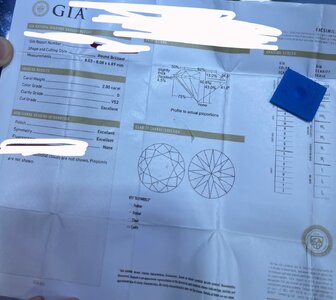




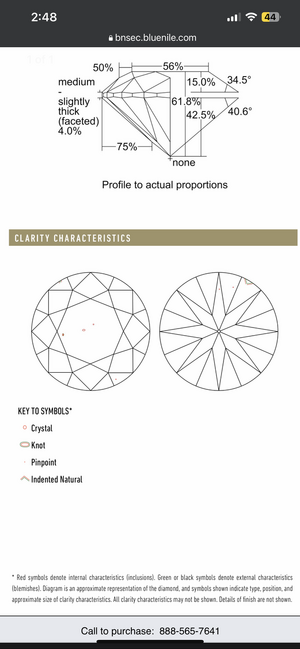

300x240.png)